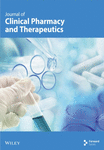Aminoglycoside pharmacokinetics in African-Americans with normal renal function
Abstract
Objective: To compare aminoglycoside pharmaco?kinetics in African-Americans with normal renal function with published adult population values. Design: An Institutional Review Board approved concurrent study. Setting: The study was conducted at Howard University Hospital, Washington DC. Subjects: All subjects had serum creatinine levels of 1·5 mg/dl or less and were receiving aminoglycoside for suspected or documented Gram-negative infection, had no obvious underlying disease condition that could influence aminoglycoside pharmaco?kinetics and were aged 18 years or older. Main outcome measures: Volume of distribution (Vd), half-life ( t1/2), elimination rate constant (Ke) and total body clearance ( Cl) were calculated using a one-compartment, open, linear pharmacokinetic model. Using an unpaired Student's t-test, the pharmaco?kinetic values of our patients were compared with general population values. Interventions: Patients receiving aminoglysides were identified by the pharmacist through the hospital's standard antibiotic order sheet. Twenty-five patients were enrolled after they met the inclusion criteria. Pharmacists made recommendations for dose change as part of standard of care when inappropriate doses were ordered. In collaboration with medical and nursing staff, the amount and time of dose administration, and steady-state peak and trough serum drug levels were stringently measured, documented on a data collection form and used to calculate pharmacokinetic values for our patients. The form was also used to document demographic information. Results: The following values were obtained: Vd 0·27±0·15 litres/kg, t1/2 1·93±1·38 h, Ke 0·31±0·134/h (gentamicin), Ke 0·22±0·10/h (tobramycin), Cl 103·95±62·98 ml/kg/h (gentamicin) and Cl 118·96±84·83 ml/kg/h (tobramycin). These values are not significantly different from general population values. Following a mean tobramycin or gentamicin dose of 1·32±0·32 mg/kg ideal body weight (IBW)/dose or 1·11±0·33 mg/kg actual body weight (ABW)/dose every 8 h, patients achieved a mean peak and trough serum drug levels of 6·6±3·86 mg/litre and 1·03±0·68 mg/litre, respectively. Wide interpatient pharmacokinetic variability was also observed. Conclusions: We conclude that aminoglycoside pharmacokinetics in African-Americans seem to be consistent with the published general population values. Thus, initiating aminoglycoside regimens using population dosing guidelines appears to be appropriate. However, due to the observed wide interpatient pharmacokinetic variability, in?dividualized dosing is required with very close monitoring, to avoid or minimize toxicity.




